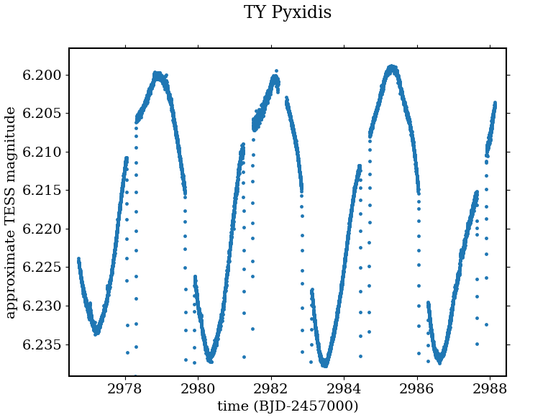New in the #VirtualObservatory: “Low-luminosity Kepler red giants analysis” by Kuszlewicz J.S. et al.
https://cdsarc.cds.unistra.fr/viz-bin/cat/J/ApJ/954/152
#ChemicalAbundances #StellarMasses #GiantStars #Asteroseismology
#Asteroseismology
New in the #VirtualObservatory: “Improved stellar parameters of Kepler RGB stars” by Wang Y. et al.
https://cdsarc.cds.unistra.fr/viz-bin/cat/J/ApJ/953/182
#Asteroseismology #GiantStars #ChemicalAbundances #StellarAges
Glad to see a descendent of another stellar evolution code that I once used putting out a fresh instrument paper (of a series to be?):
https://arxiv.org/abs/2511.02801
I've always found Cesam2k20 particularly interesting because I think it has the most advanced treatment (among 1D codes) of rotation, and because it possibly uniquely uses a collocation method to solve the spatial equations.
Find out more about the code at their website:
For #asteroseismology, Kepler's sensitivity and observing duration is unparalleled. TESS has been exciting for otherwise-interesting bright stars but I've felt K2 was neglected. The 90d baseline is valuable but the systematics gnarly. So I'm delighted to see Hookway et al.'s (2025) analysis of solar-like oscillators in the K2 "KEYSTONE" sample.
https://arxiv.org/abs/2510.21626
Here's an example power spectrum for a late subgiant, where the symbols indicate individual oscillation modes. 🤩
New in the #VirtualObservatory: “Beyond the Nyquist frequency” by Liagre B. et al.
https://cdsarc.cds.unistra.fr/viz-bin/cat/J/A+A/702/A144
#Asteroseismology #GiantStars #ChemicalAbundances #VisibleAstronomy
It's still #TESStuesday! And today's there's some neat #asteroseismology.
You may have heard of the "Methusaleh star", which is very old but I honestly don't think was ever a challenge to the accepted age of the Universe. But this study of the oscillations based on TESS data is nevertheless interesting because it's very poor in metals relative to other asteroseismic targets, and shows that our rough rules for oscillation properties seem to deviate at low metallicity.
New in the #VirtualObservatory: “TESS Luminaries Sample. I.” by Lund M. N. et al.
https://cdsarc.cds.unistra.fr/viz-bin/cat/J/A+A/701/A285
#DwarfStars #Asteroseismology #GStars #SpectroscopicBinaryStars
I might incur 13.7 days of bad luck for sharing a non-TESS light curve on #TESStuesday but this multi-band light curve from the brand new Vera C. Rubin Observatory's commissioning data is too good. 🤩
This is a distant (16.6kpc), faint (18th magnitude) SX Phe variable but the light curve has the unmistakable shape (in the optical g band) of a δ Sct/SX Phe variable.
NASA's TESS satellite serendipitously observed the 2019 eclipse of γ Per and I'm delighted to see it got some attention in a poster by László Molnár, Rozália Ádám and collaborators at this year's KASC15/TASC8 conference (basically the biggest annual #asteroseismology conference):
https://zenodo.org/records/13641744
(The imaged light curve is my own but in essence the same as one in the poster.)
This #TESStuesday, I offer the eclipsing binary TY Pyx. Nothing at all made me think "I don't think I've ever looked at variables in Pyxis", so I grabbed something at random from the GCVS. So here it is, with very spotty out-of-eclipse variations also make it an RS CVn variable. Spectral type is G5IV+G5IV so I tried my hand at finding solar-like oscillations but I didn't find anything (though I didn't try *that* hard).
I just learned that a recording of this year's Crafoord Prize Symposium in #Astronomy, which happened on Wednesday, is available online. This year's laureates are Douglas Gough, Jørgen Christensen-Dalsgaard (aka JCD) and Conny Aerts, for developing helio- and #asteroseismology.
https://www.youtube.com/watch?v=HMwMsHj0K1U
You can find the programme here:
https://www.kva.se/en/event/the-crafoord-prize-symposium-in-astronomy-2024-2/
Big thanks to the Royal Swedish Academy of Sciences for making this available so promptly!
New in the #VirtualObservatory: “Asteroseismically calibrated ages for APOGEE DR17” by Boulet T.
https://cdsarc.cds.unistra.fr/viz-bin/cat/J/A+A/685/A66
#GiantStars #StellarAges #MilkyWayGalaxy #Asteroseismology
For #TESStuesday, I recently came across Tobin et al.'s discovery of a substellar companion around the γ Dor variable HIP 39017 (= V769 Mon). The TESS light curve (some of Sector 7 shown) does *not* disappoint.
In Nature yesterday:
"Smallest known starquakes are detected with a subtle shift of colour: An unusual technique picks up the slow vibration of a faint star."
"Unusual"? I guess in a very specific sense it's not wrong to call a radial-velocity detection of solar-like oscillations "unusual" but I feel like it betrays that RVs are
(a) how we measure solar oscillations and
(b) how solar-like oscillations were first detected.
Advancements in Asteroseismology Explain Red Clump Stars' Pulsations https://researchinenglish.com/article/2024.3/advancements-in-asteroseismology-explain-red-clump-mfgpjotl?utm_source=mastodon&utm_medium=social
#astrophysics #science #research #modelling #stars #asteroseismology
For #TESStuesday, I bring the rapidly-oscillating peculiar A (roAp) star γ Equ, whose pulsations I didn't know about until I saw this paper by Järvinen et al. in which they study the magnetic splitting (Zeeman effect) in its spectrum.
The TESS amplitude spectrum (data in Sector 55) is a textbook roAp star, with a strong peak at a period of ~116 c/d = a period of ~12.5 minutes.
I only learned today that Wasaburo Unno died two months ago (Nov 7, 2023). Apparently he's best known for a formula (the Unno—Rachkovsky formula) for deriving magnetic field strengths from polarimetry, but I expect everyone in #helioseismology or #asteroseismology will know him for his famous textbooks on non-radial stellar pulsations.
You can learn more about him from his obituary in Solar Physics:
https://link.springer.com/article/10.1007/s11207-023-02238-y
#TESStuesday is not forgotten! On arXiv today, Sepulveda et al. show amplitude spectra from TESS of the definitely-δ-Sct-variable HIP 65426 (HD 116434), whose orbiting planet was the to be imaged by JWST (Carter et al., 2023). It rotates crazy fast (jargon, sorry): vsini ≈ 280 km/s, rotation period ~7.3h so the echelle diagram lacks any patterns that we recognise (yet?).
Just uploaded the "asteroseismic" HR diagram I created for my review in A&G to the Wikimedia Commons and added it to the @wikipedia article on #Asteroseismology. Use it and edit it to suit your needs!
It's also taught me that SVG is a bit of a weird format. I can't paste it here and there are a few flaws in the online preview version that I can't reproduce...
https://commons.wikimedia.org/wiki/File:Asteroseismic_HR_diagram.svg
Just missed another #TESStuesday but here are the clear solar-like oscillations in β Hyi anyway, using 20-second data from TESS Sector 67. TESS's PI recently spoke at a conference in Hawai'i and revealed that the spacecraft—already 5 years into its mission—could last *decades*...




